In today’s budget-constrained environment, there is a high level of scrutiny on how products and services drive business outcomes — and eCommerce is no exception. If a user goes to your eCommerce site, and your site takes too long – shoppers will leave without buying which will ultimately lower your site’s overall conversion rate. Don’t lose users because your site is slow. Let YOTTAA help!
YOTTAA helps over 1,500 eCommerce sites improve page speed and overall site performance. We have historically seen first-hand that conversion rates increase when sites become faster. But is there further evidence to support that faster page load times lead to higher conversion rates? Yes, there is.
Based on our own experience, we can state that there is a strong connection between page load time and conversion rate.
What we did
In the context of an eCommerce site, the average page load time (using onload timing metric) was captured for all sessions over several days (no sampling). Sessions were placed into ten separate page load time buckets (fastest on the left in the graph below and slowest on the right) where each bucket contained the same number of sessions. The conversion rate was calculated for the given sessions for each page load time bucket.
Learn more about onload page load time and other eCommerce timing metrics
The results surrounding the conversion rate
A staircase-like graph illustrates better conversion rates at faster page load times and a steady drop as pages took longer to load:

In this example, comparing the average page load time of 2.2 to 3.2 seconds shows a stark difference in the conversion rate. When translated into revenue, one second can be very significant.
Ok, we know what you’re thinking… it would be easy to cherry-pick a single site to match this story. That’s why we ran the analysis on many sites and the results were similar:
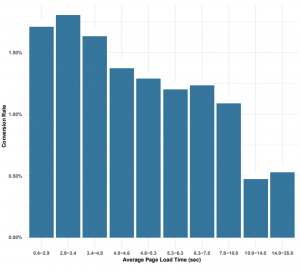
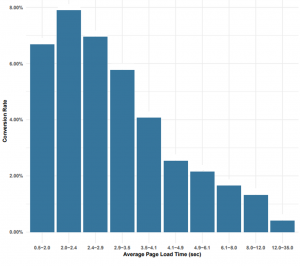
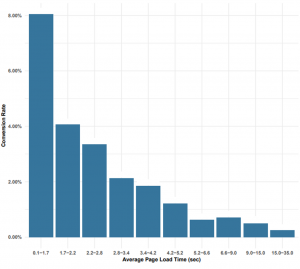

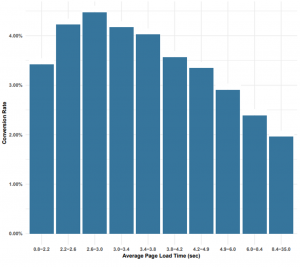

While conversion rates vary between these sites as well as the specific impact of page load time on conversion rates, the trend of slower load times leading to lower conversion rates is consistent.
How to optimize site speed to help your conversion rate
There are many factors that impact site speed, and each one needs constant and careful management. Taking the DIY approach can be sort of like managing a long escalator that constantly needs fixing, and sometimes forces disgruntled visitors to take the stairs or find an alternative. You could also partner with experts with 10+ years of experience in increasing site speed for thousands of sites across verticals and eCommerce platforms.
Page Load Time optimization in action
Below is another analysis comparing the distribution of YOTTAA-optimized sessions (blue bars) vs. control or unoptimized sessions (gray bars) across 0.5-second page load time buckets where the corresponding conversion rate is the orange line:
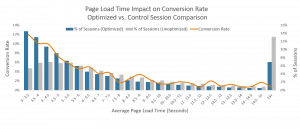
Again, the conversion rate is better at the faster page load times, where we also find a much higher percentage of YOTTAA-optimized sessions compared to control sessions.
Leveraging a faster eCommerce site
eCommerce professionals understand very well the significance of even just a fractional improvement in conversion rate and how that translates to appreciable business outcomes. And although harder to measure, they are also keen on providing a modern and consistent shopping experience that won’t add friction to the buying process. Now you can also better understand how site speed positively impacts the bottom line, an imperative element when making any type of investment, especially when spending is tight.
Interested to see how site speed impacts your eCommerce site? Sign up for free measurement and learn how slower page load times are impacting your conversion rate, or get in touch to see how YOTTAA can (literally) step up your site speed and deliver more meaningful business outcomes.

